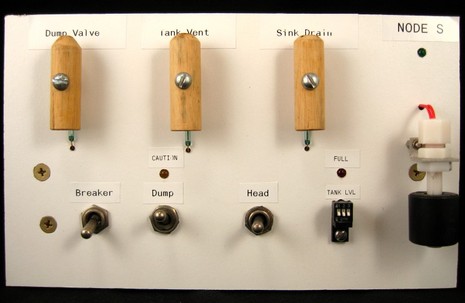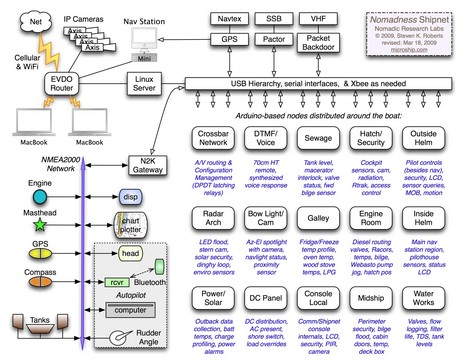Shipnet, “reality tagging” on Nomadness
Zounds! When we last checked in on Steve Roberts, he was installing a Simrad AP20 with a rudimentary NMEA 2000 network, and waiting on a Furuno NN3D MFD12. It was pretty standard stuff for a guy who’s into “geek expressionism, gonzo engineering, gizmological expeditions, and applied technomadics.” Well, check out Steve’s current vision of the network that will eventually reside on his 44-foot steel pilothouse cutter Nomadness. I think he changed his mind on the Furuno — too bulky for his helm — and is still undecided on the plotter/radar front, but, wow, has he been thinking about communications and system monitoring/control. Steve explains the whole diagram here, but let me just add that all those nodes lower right are based the interesting open source Arduino I/O project…
Steve calls his home built Arduino-based nodes “Busy Boxes” and he’s already beta testing the “sewage” model (below). He’s also started selling gear — like this simple magnetic position sensor kit — for similarly inclined boat geeks, and he’s planning a book on this whole Shipnet project.
 I think it’s all neat, and look forward to following Steve’s adventures on the cutting edge of DIY. I was particulary struck by his answer to the query “is there a danger that the complicated gadgets will distract from the fundamental operation of the boat, negatively impacting seamanship?”
I think it’s all neat, and look forward to following Steve’s adventures on the cutting edge of DIY. I was particulary struck by his answer to the query “is there a danger that the complicated gadgets will distract from the fundamental operation of the boat, negatively impacting seamanship?”
Well,
not if I do my job right. The idea in all this is not to tinker
endlessly with gadgetry, but to strike a balance between the kind of
stuff I find most amusing and the practical needs of maintaining an
18-ton voyaging machine. None of this should ever be in the critical
path to basic sailing and primary safety; it is instead a layer of
“local situational awareness” that is intended to tag reality with
additional information… and otherwise stay out of my way.
I’m with Steve. Just last Friday I had a similar conversation with a boatbuilder who was annoyed at all the possibilities he faced outfitting a blue water cruiser. “Too many damn screens,” he grumbled, “the boater gets distracted and doesn’t get his head out!” I won’t argue with that, and I’m guilty myself sometimes, but I do think that we’re working toward boat systems so integrated and intuitive that we will be less distracted by them. Which will gives us more time to be aware of the world outside the boat, for safety and for pleasure.














Thanks for the kind words, Ben!
On the latter point about integrated boat systems, one of my mental models is Star Trek (TNG and later), with distributed awareness built into the ship. Of course, that rig didn’t work so well during a complete power failure or interstellar equivalent of a lightning strike, so it’s not exactly the right metaphor for a sailboat… but I do appreciate the reduction of complexity to voice and graphics visible at any station. I’ll keep strings for the sail, hydraulics for the rudder, and cables for the Yanmar, though!
Also, just for the benefit of anyone looking askance at the clunky non-marinized hardware in the above photo, that is just one of the development stations (every node has a mockup in the lab since I’ve never been a fan of all-software simulation for embedded system design). Actual packaging is conformally coated printed circuit boards in little gasketed boxes for the remotes, as well as the dense mass of RFI generators snuggled up with the comm gear in the folding console. <shudder>
Cheers from the lab!
Steve
I think you touched the Grail, Ben, when you said “we’re working toward boat systems so integrated and intuitive that we will be less distracted by them.” The painless assimilation of diverse data should be the first goal of information technology in cockpit and bridge displays. We should be striving for situational awareness; enhancing comprehension and integration of multiple facts rather than diverting the watchstander’s attention with different gui’s and requiring a lot of mental arithmetic to decide what’s worrisome and what’s eye candy. This in no way implies “dumbing down” any data. Rather it adds to the designer’s task list of calculating the data’s priority in a varying set of conditions. Being anchored in 12 feet of water means that a 24′ draft vessel passing nearby does not merit a call to general quarters. But a change in the predicted path of a summer squall 20 miles away should be brought to the attention of the helmsman before he gets thru changing CDs on the audio system. Some intermediate level of ‘advisory’ would be appropriate for a change in heading that will cross into shallow water. Perhaps there could be a let-me-know-when setting for the next turn, a reported wind change, or when the coffee is ready.
I believe that a single display is the best solution, albeit with enough single purpose instruments to provide emergency backups. Alerts could scroll across the screen and be silenced with a touch, or reviewed just as easily.
And if we are so worried about lightning strikes taking out the electronics, let’s address that issue too, with isolated, protected, redundant backups. Why should all our batteries fail simultaneously? Why can’t there be surge protectors for our oh so expensive gadgets?
There is not a fine line between informing and distracting; there is a science called Human Engineering!
Sandy – good thoughts on the human engineering. I hobnobbed in the Usability community for a while (even keynoted at a UPA conference) and have developed a real appreciation for things that fade into the background while adding usefulness (unlike, say, 99% of all media-center remotes).
The easiest way to leverage off-the-shelf tech for the “single screen” model is of course a web server, and that’s what I’m doing on Nomadness. Any station or laptop brings up the local site as its home page, and since it’s database-backed, the content is live (while also providing easy hooks to static documentation). One of my favorite parts addresses something that is a personal weakness of mine: keeping up with preventive maintenance. One page on the site is a dynamically generated to-do list based on elapsed time and other factors (“Check the Racors!”).
Of course, having to fire up a browser is itself invasive, so there is also an always-on discrete display for alarms and other exceptions. Each node also has a “health” LED that takes on a distinctive blink pattern if something is wrong, prompting a closer look (like somebody turned on the macerator without opening the tank vent, though in practice there would probably be olfactory indications much more compelling than a blinkie!)
Cheers,
Steve
I’m an avid fan and a wannabe mad scientist, Steve. An advantage of a server includes a one or two line, scrolling display (with a wide range of intensity) for messages like “collision alert, zoom out to see AIS target on the big screen” or “sunset, turn on anchor light” or “Barometric pressure dropping, check weather.”
I’ve become particularly fond of speech in a busy setting, Sandy… it’s nice to have the system grab my attention through a familiar channel. In addition to the native display on the console (that I have to remember to check), the system can route synthesized speech strings to the stereo or yank the push-to-talk line on any of the radios and give me a call if I’m not aboard. If something is urgent, it is prefaced by a suitable alarm sound.
I like your examples. I should start making a list of such “event notifications.”
Cheers,
Steve
Awsome! But don’t let it wake up the off-watch. Your difficulties could thereby be compounded.
“Warning! Crew EEG has transitioned from REM to full-awake status. Prepare emergency chocolate.”
Sorry to report that Steve Roberts has moved ashore for various reasons, but it also means that the mighty 44-foot steel cutter Nomadness is available to another geek sailor with many of Steve’s projects already complete:
http://nomadness.com/amazon-44-for-sale